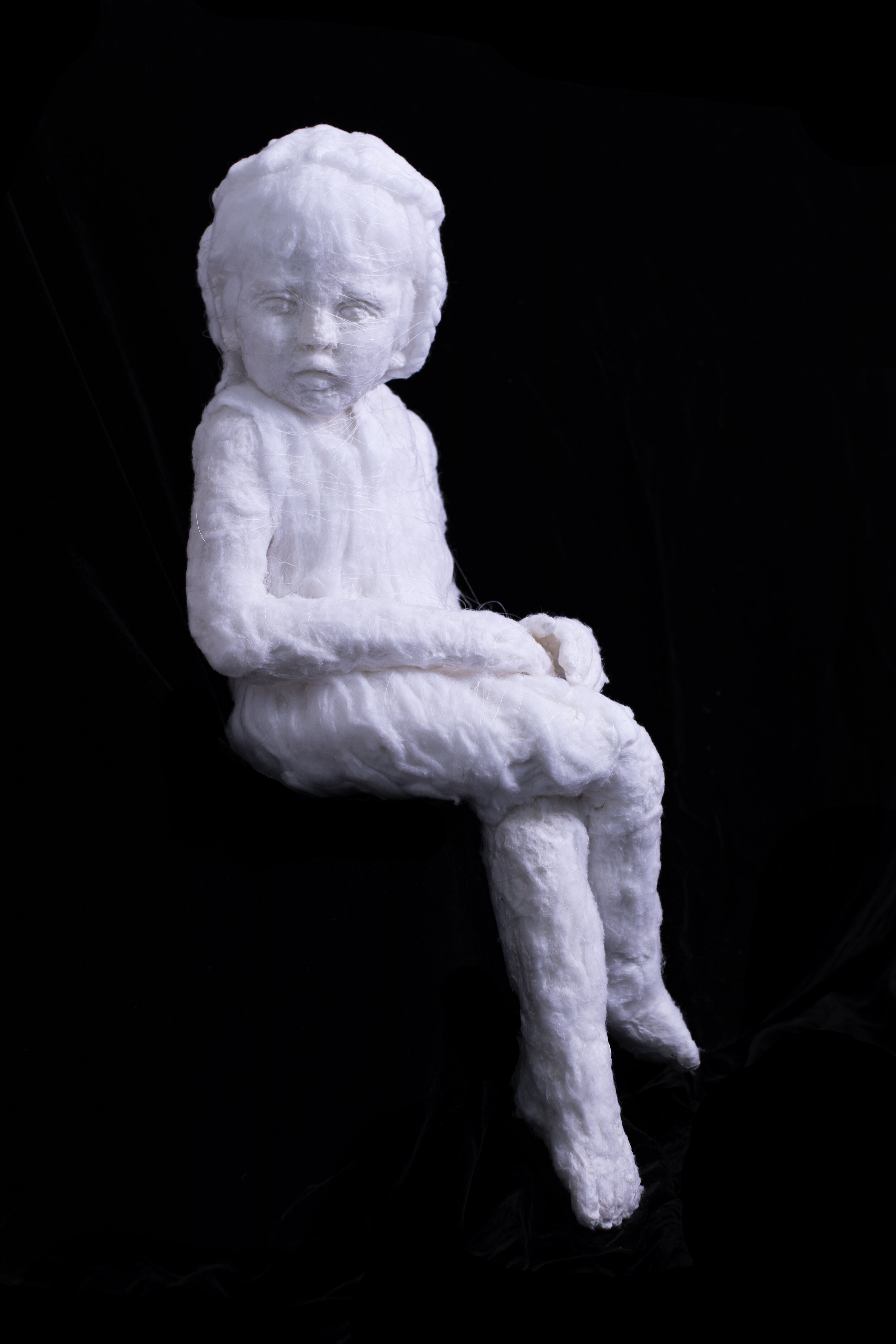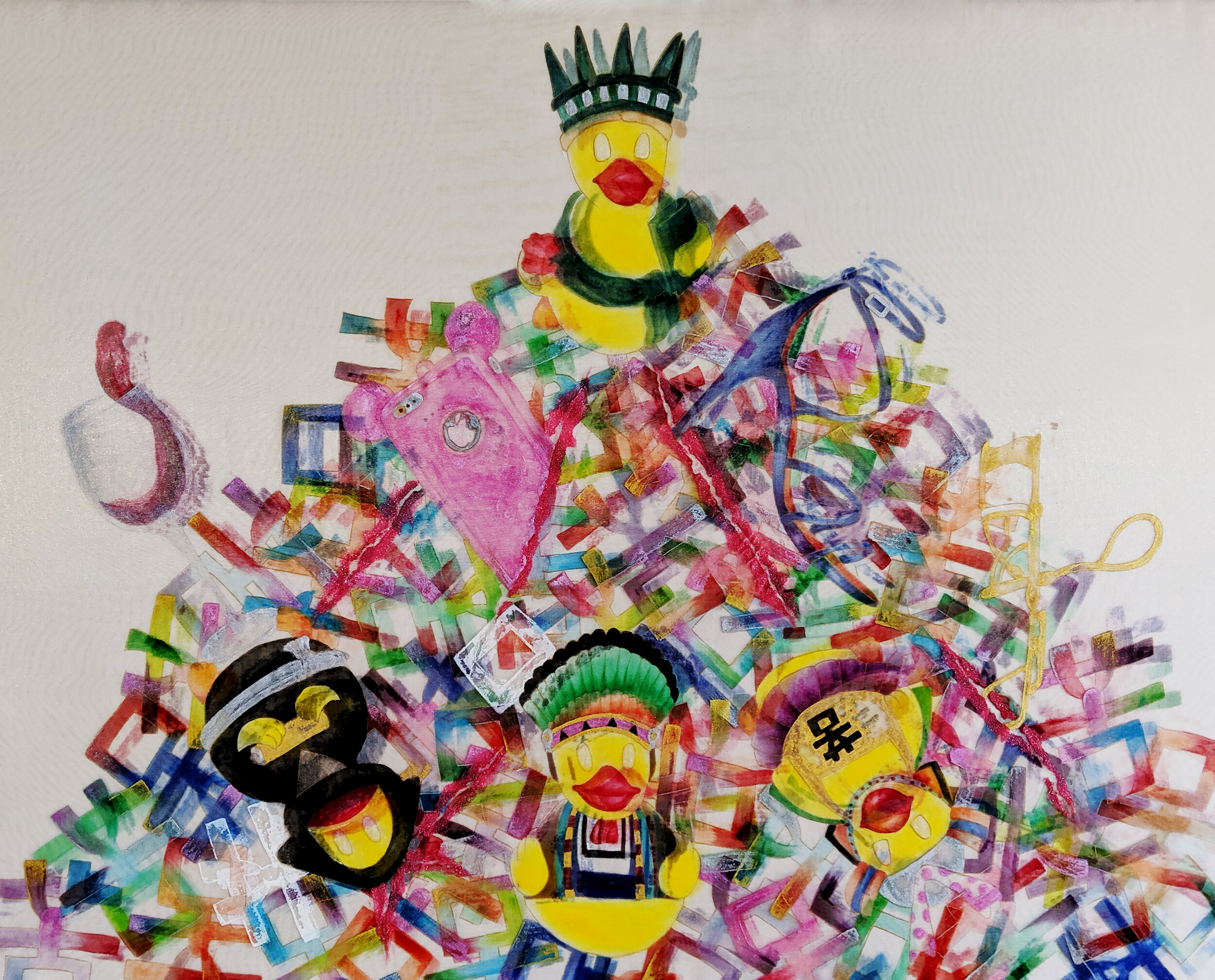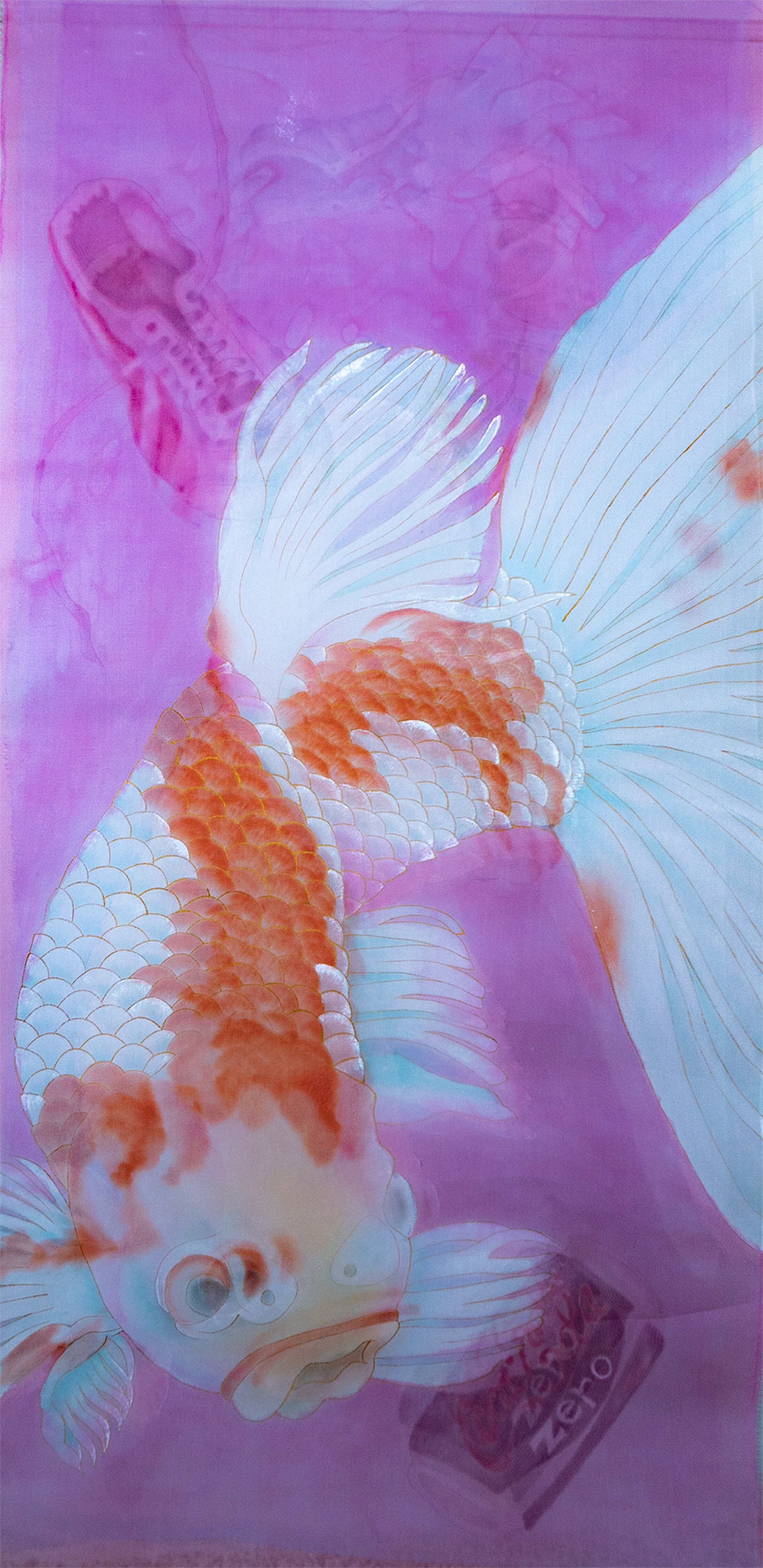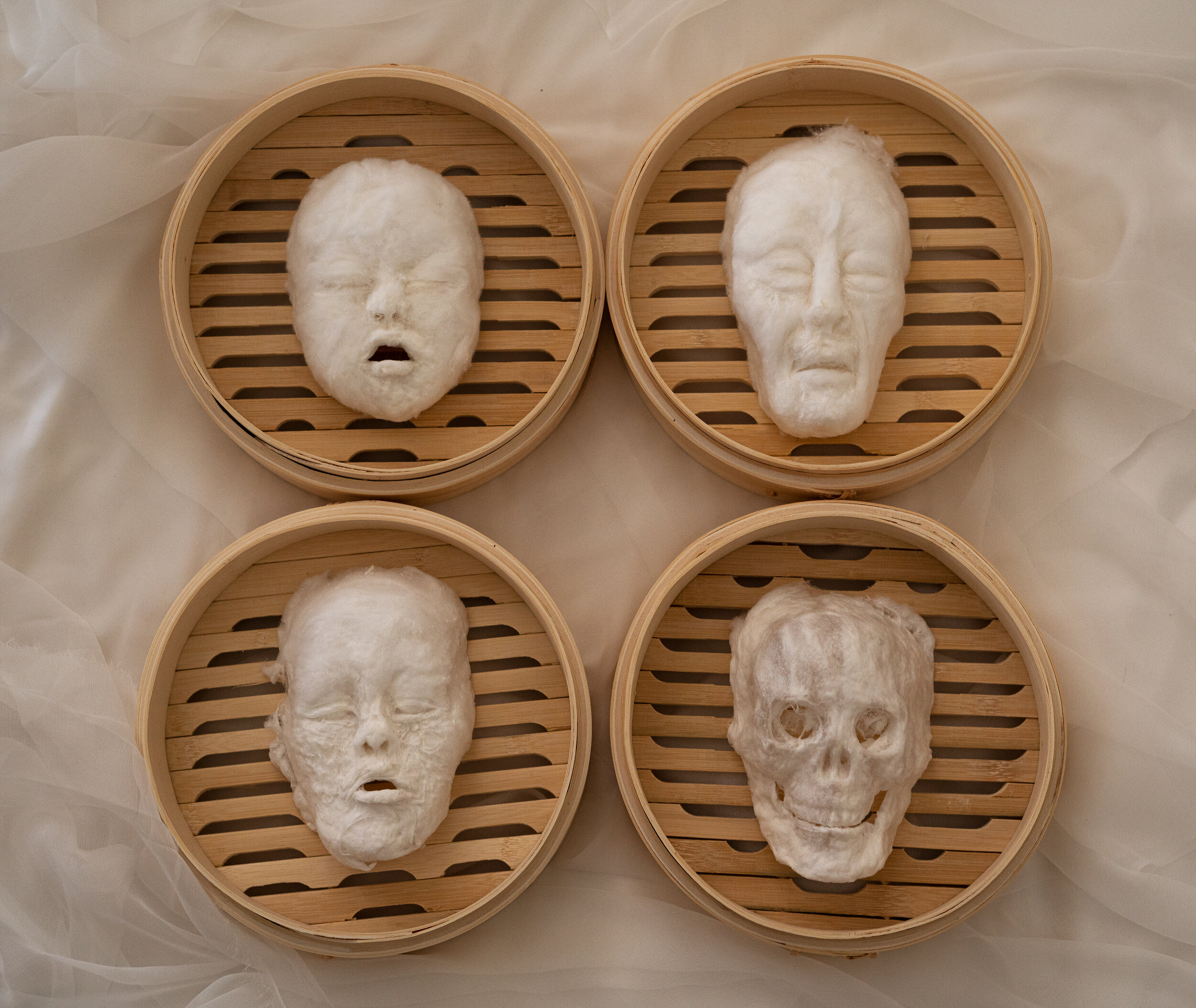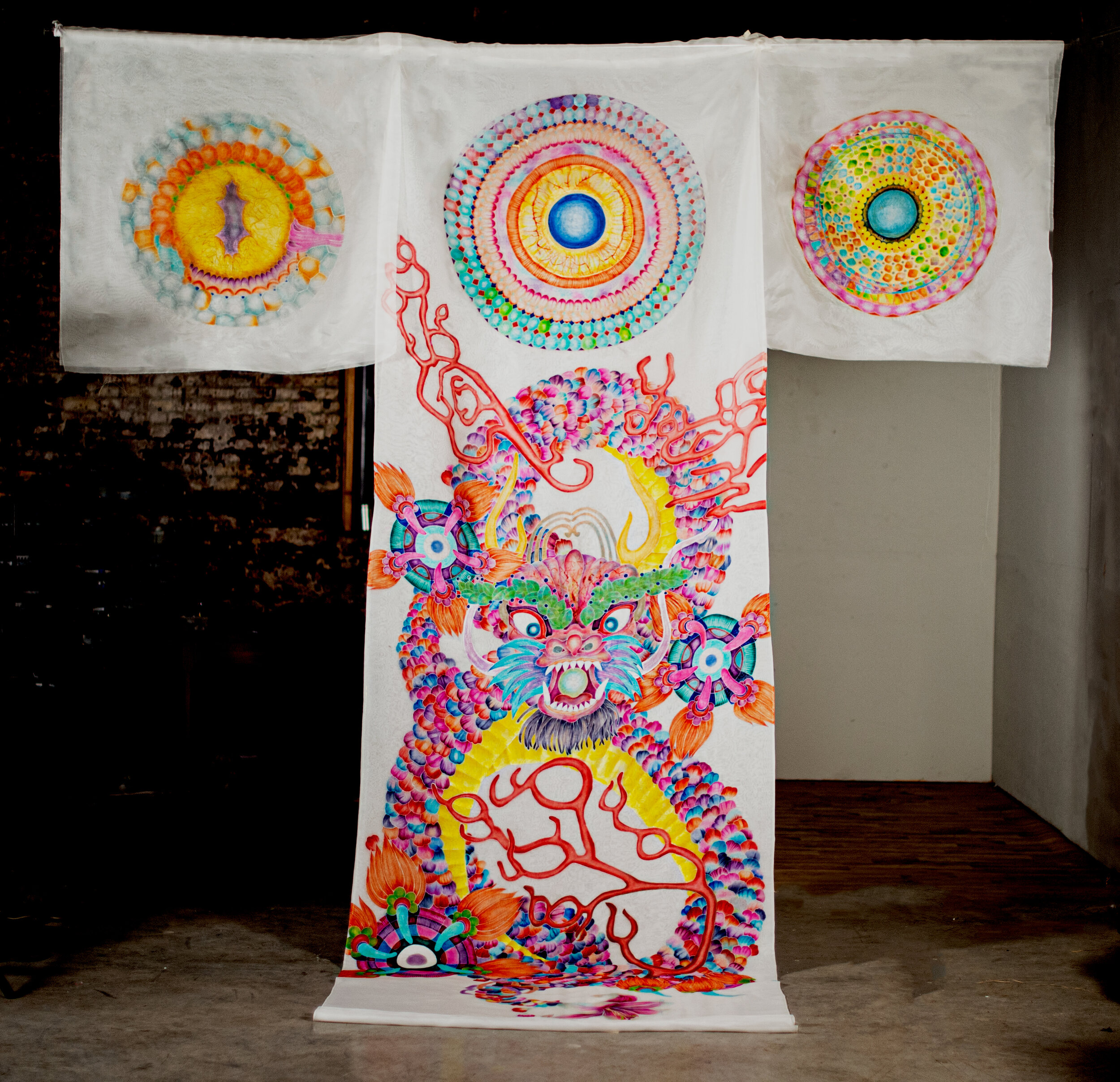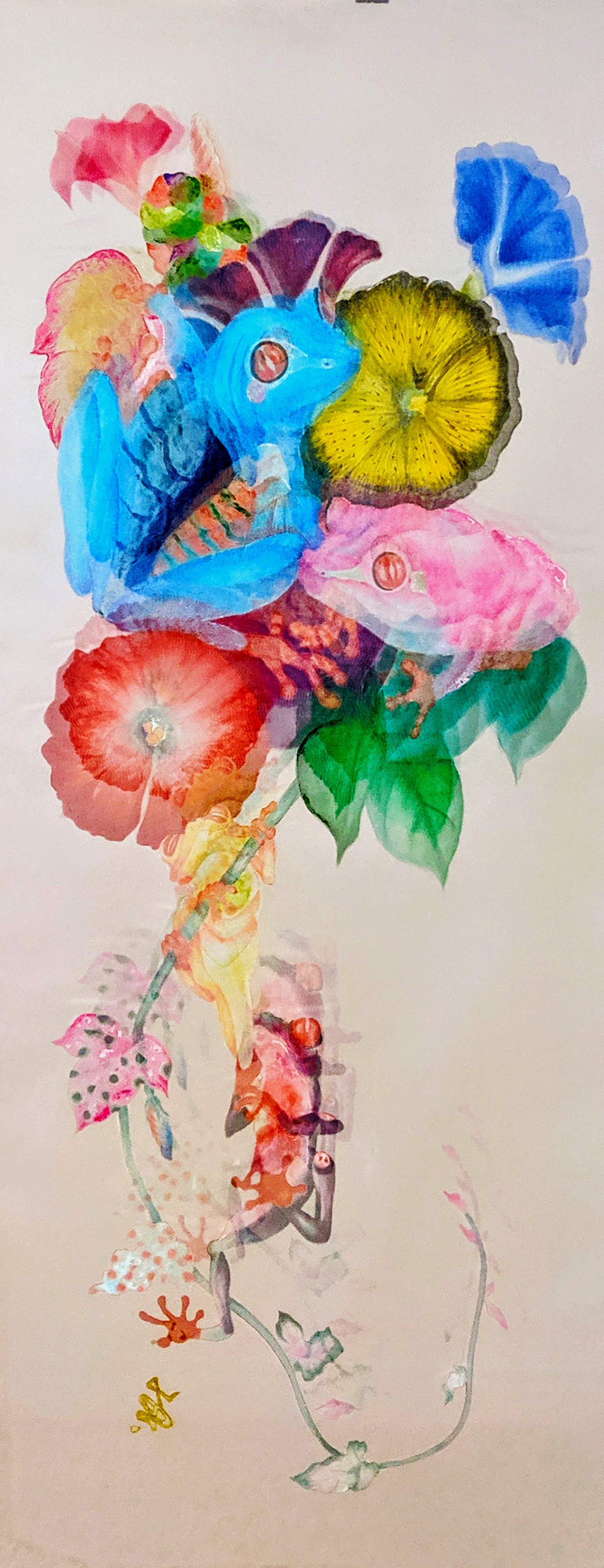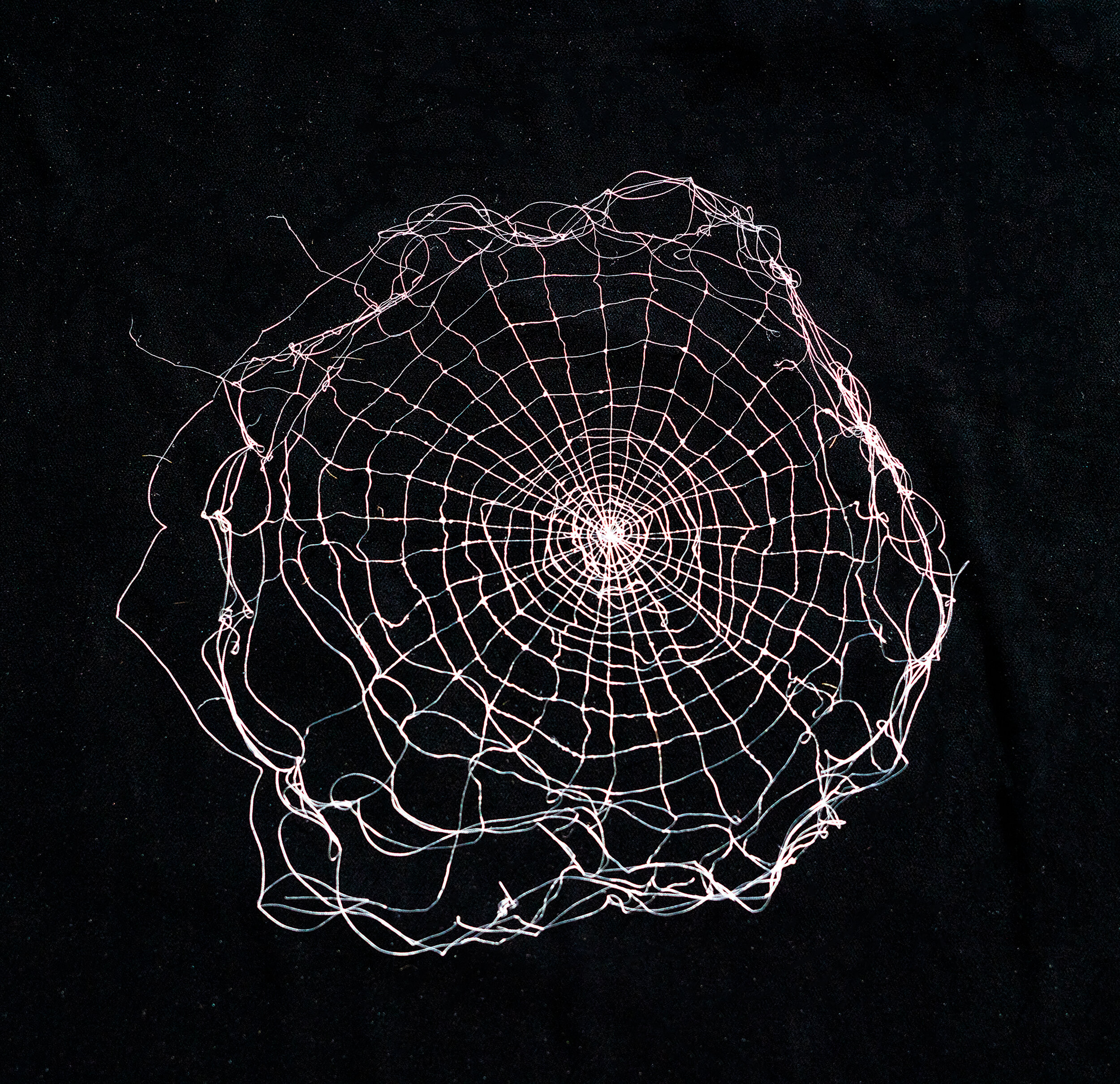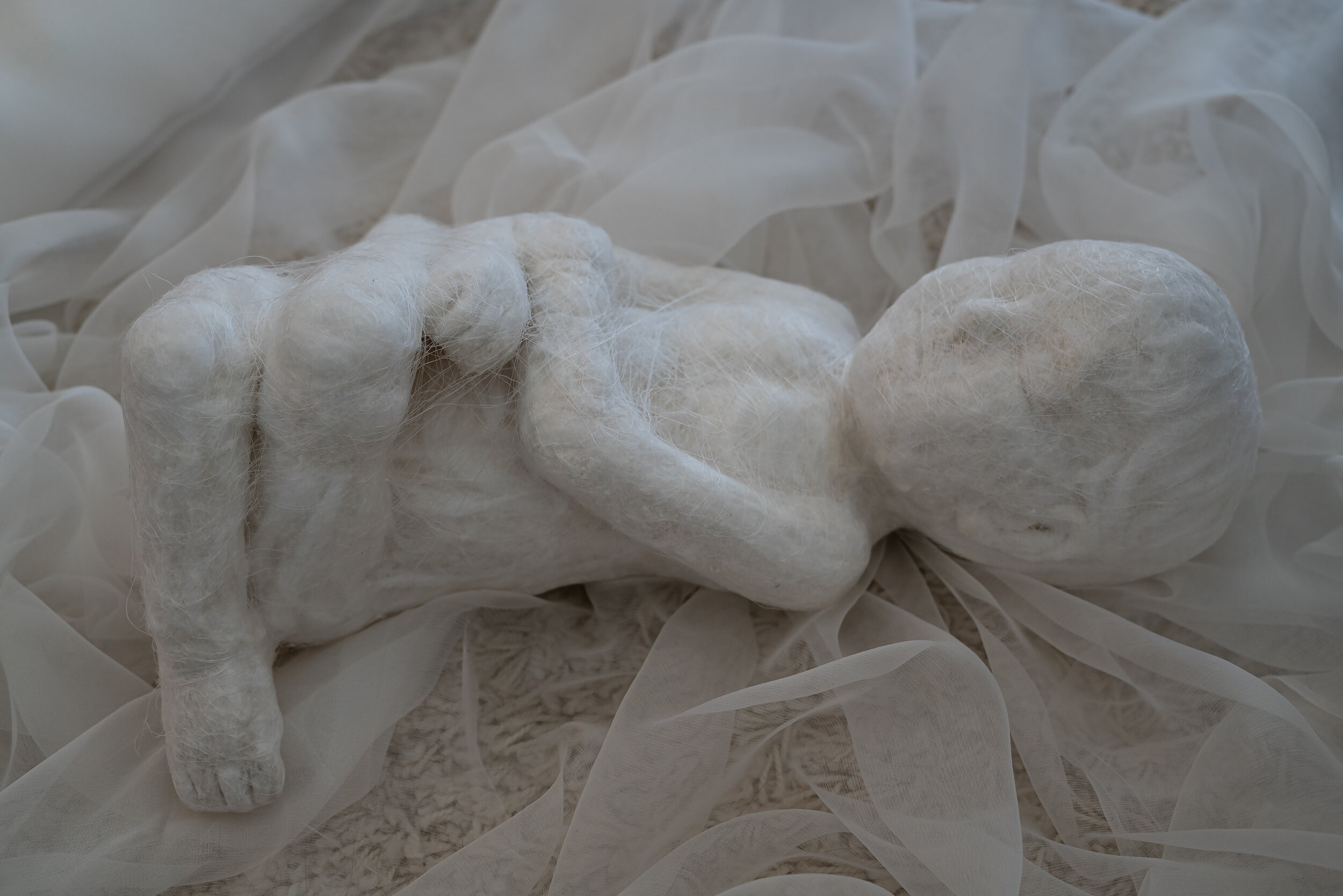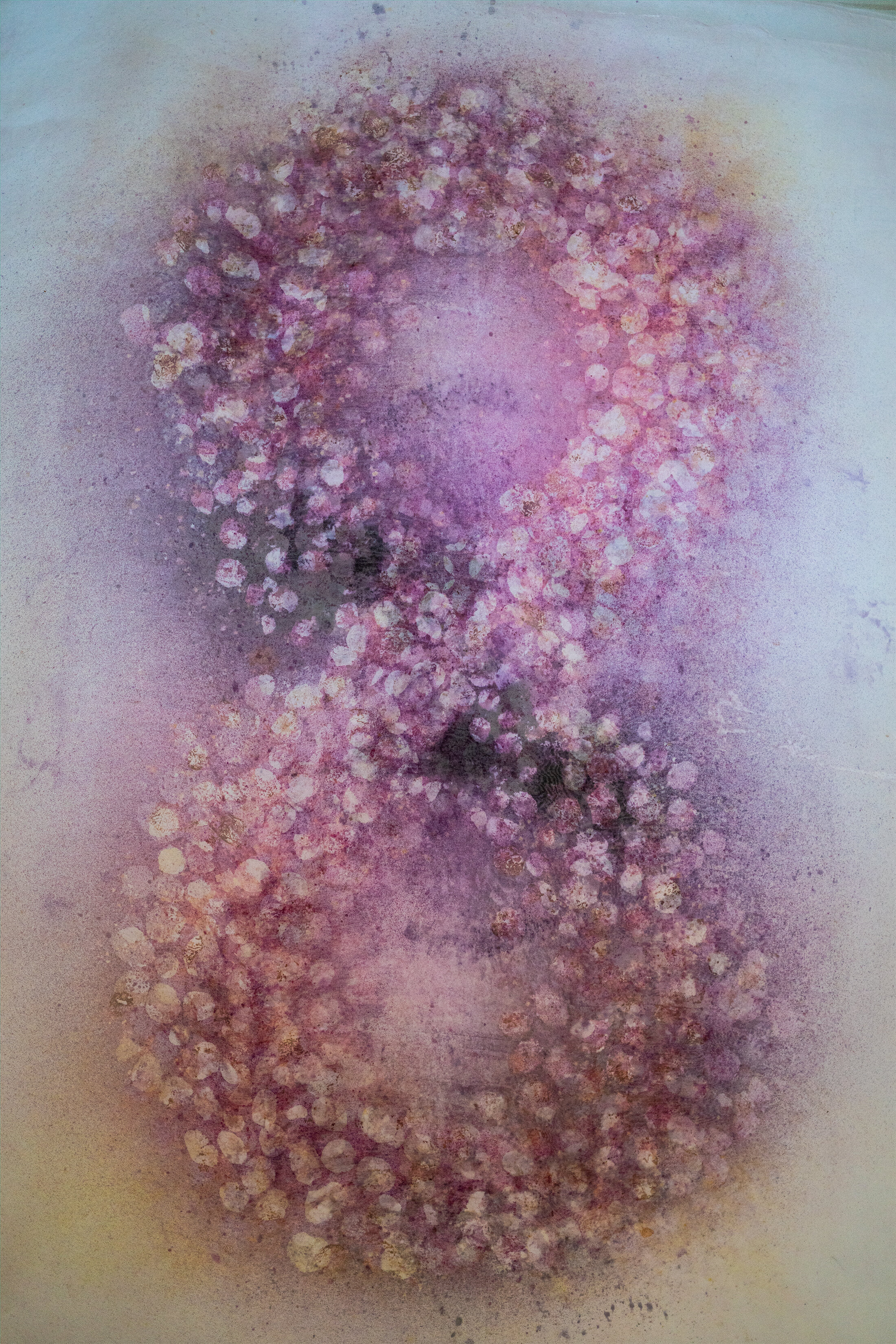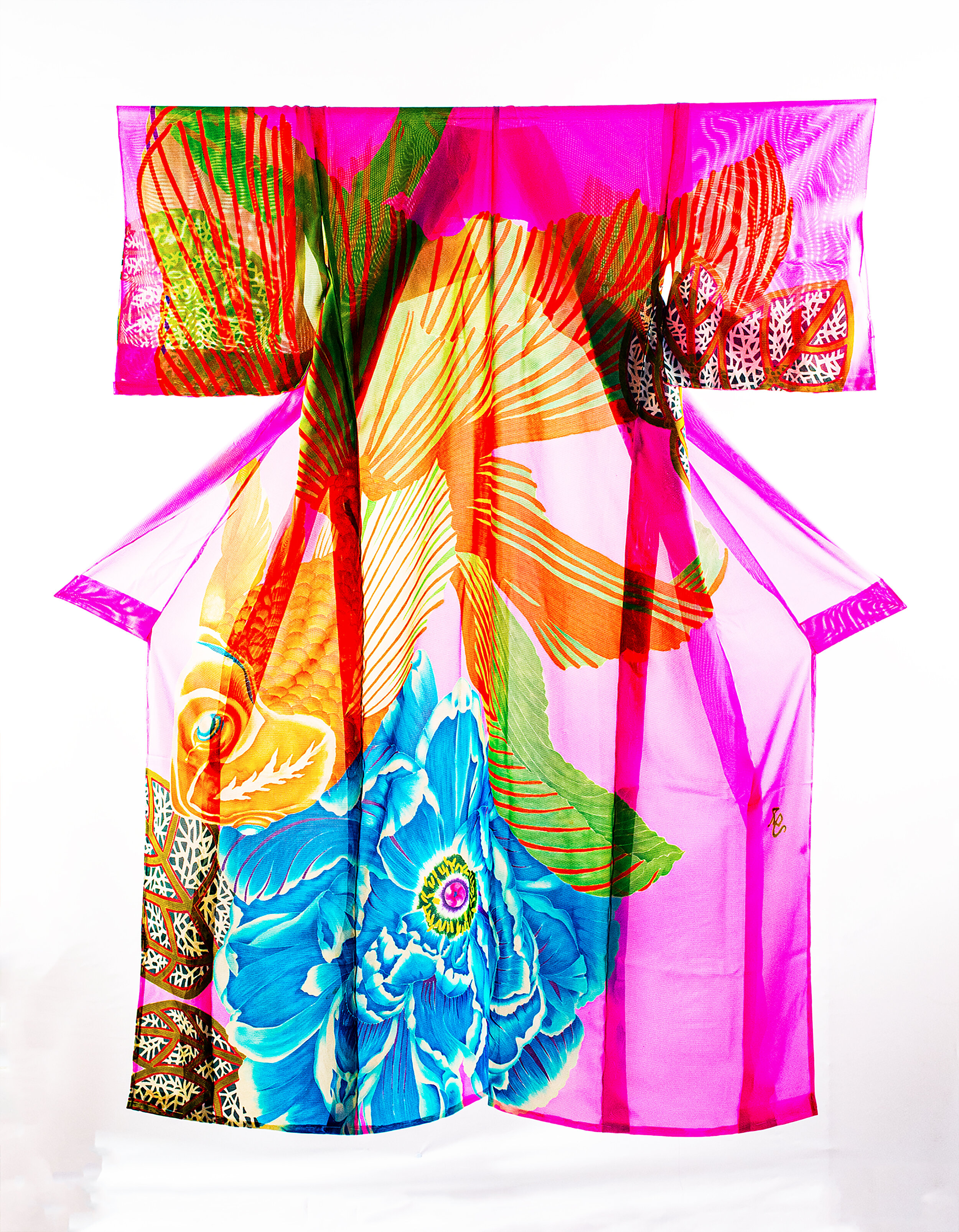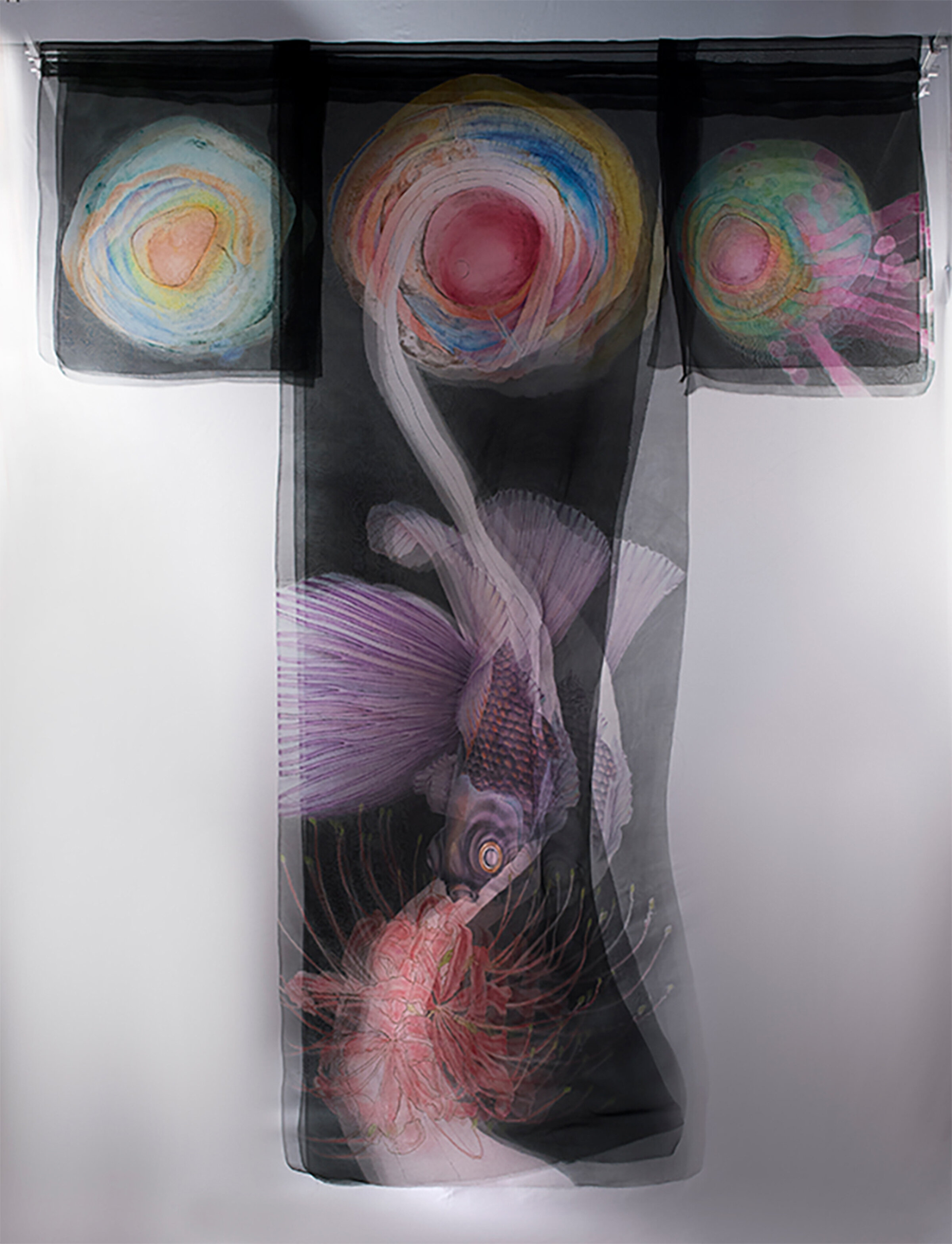Interview with Aomi Kikuchi
Aomi Kikuchi is a creator of innovative fine arts inspired by Buddha’s Philosophy, impermanence, insubstantiality, and suffering of all life. She started her career as a fashion designer, and she has a professional Yuzen Kimono Dyeing skill with about thirty years career. While she has a strong obsession with silk fabrics, she tries other materials, which have femininity and fragility such as fiber, goose down, cotton flower, glass, and film. Her artistic practice has been expanding from two-dimensional work to installation, sculpture, and film work. She received BFA from Kyoto University of Art and Design, and MFA from Pratt Institute.
Can you pinpoint the moment you decided you wanted to become an artist?
I visited MiamiArtWeek in December 2014. Until then, I had been working in the field of modern crafts in Japan. After this experience, I decided to work in the world of fine arts. I then went to New York to study fine arts and received my MFA from Pratt Institute in 2019.
Where is your studio and where are you from?
I was born in Japan and have lived in Tokyo for a long time since adulthood. Currently I live in Brooklyn and have two studios in the Textile Arts Center (TAC) and Trestle Art Space (TAS). I did a residency at TAS for six months and I am a member of TAC residency cycle 11 until June 2020.
Tell us a little about your artistic background. What were your first influences to be creative and become a serious artist?
I wanted to work creatively and so I learned dress making and fashion design. My goal was to become an haute couture designer, but I started my career as an apparel designer. That is because there was no school for haute couture in Japan and Japanese designer’s brands were in their heyday at that time. I was able to join the most popular and competitive apparel company as a newcomer. Planning and drafting were my main work and manufacturing was handled by low wage sewing workers, and I saw a problem with the mass disposal. I felt uncomfortable in such situations and I left the company after marriage. My enthusiasm to deepen my knowledge of making things continued and I learned craft techniques such as Yuzen dyeing, Japanese embroidery, pottery, ceramic painting, Japanese silk braiding, and bisque dolls. Especially, I thought that Yuzen kimono dyeing could be the Japanese haute couture. There was a fateful encounter for me to find a dyeing school of Itchiku Kubota, a master of dyeing, next to a shop I dropped by to get a drink for my daughter.
Kimono dyeing is accomplished by division of labor by specialists in multiple processes. In the 1990's when I started learning Yuzen dyeing, the majority of Japanese had already stopped wearing kimono except for ceremonial occasions and the aging of craftsmen and a shortage of successors were occurring. I wanted to know all the processes and also had a sense of mission that I must learn them. Starting off with the Itchiku dyeing school, I subsequently asked multiple craftsmen to teach me. As they also felt that the transfer of kimono techniques would not be carried out, they shared the hidden skills to me, which was something that had long been taught exclusively to their sons and their disciples (called Isshi-soden). Itchuku Kubota was a Yuzen craftsman, but he became an artist as he revived and reinvented Tsuji-gahana, a dyeing technique, which thrived for decades around the 16th century. He accomplished this after many years of trial and error. He was awarded an honorary medal in France, had a solo exhibition at the Smithsonian Institution, and was active worldwide. He was a great creator I met for the first time in my life, and seeing his aesthetics, commitment and inquisitiveness had a great influence on me.
Can you tell us what you have going on right now?
At the Trestle Art Space, I work on pictorial expressions based on Yuzen dyeing on the layered organza. From 2020, I am planning to use natural dyes for pictorial work, and I start with a goldfish piece that has been used as a motif many times. Goldfish is a symbol of human ego for me. This is because human beings continue to breed them for appreciation purposes and forced them to have too large eyes, stomachs and fins. I also started to draw a draft themed the Gion Festival in Kyoto, one of the three major festivals in Japan, and the child who rides the first float called Naginata-boko who cuts the rice straw rope stretched on the street and announces the beginning of the Yamaboko parade. The Gion Festival began in the 9th century to calm the demon that was believed to cause the repeated disasters and plagues. The Yamaboko parade was in danger of survival in the 16th century and has been protected and continued by the power of the townspeople. In an old portrait, his brilliant and heavy costumes and his nervous expression tell the child's responsibilities as a divine messenger. I want to express his courage and fear from receiving all the praying of people, their wishes, and attention.
I have been a member of residency at the Textile Arts Center since last October. I have participated in workshops to learn techniques such as machine knitting, weaving, spinning, silk screening, and natural dyes. I will learn about the history and restoration of textiles and how to write grants by June. There are eight members in the residency group, and in the center, there are staff and a variety of people including children who learn textile techniques and create works. This studio is fully equipped for textile art, and it's like a wonderland for textile artists. Recently, I shaped letters using a worn-out stocking to make screen-print. I created “Infinity” symbol using these letters with natural dyes, which were left over from a workshop. I made a weaving sampler using various threads. I'm going to make big silk screen print works and weaving including kimonos.
I also work at home. I'm making machine knitting kimonos. In addition, sculptures made of cotton and water-soluble glue is currently producing a full-sized bust of my mother with my mother’s wedding photo as a reference. Prior to this work, I made a sculpture of a newborn nude under the title Suffering-Birth with my grandson as the model. Works imitating a culture of mold in a petri dish are made using goose down, mica and resin. Dragonfly, Moth, Mosquito and other insects are produced in three dimensions using embroidery techniques with wire, extremely thin silk, goose down, cotton, and mica.
Can you describe what an average working day for you is like? Do you work on many creatures at once or one at a time?
I work almost every day. I work at home in addition to the two studios. I have several projects at once. I want to present as many new works as possible for the exhibition, so if the exhibition schedule has been decided for months, I try to create new works taking into account the size of the place to be displayed and the concept of the exhibition. Apart from that, I freely create my own works and various experimental works.
What makes your art different than others?
My work can be described with five keywords: Buddha, Japan, Edo, Environment, and Crafts.
“Buddha”: My artist statement is Buddha’s philosophy that life is impermanent, insubstantial and suffering. I lost my mother at the age of nine and experienced heavily about the impermanence of this world. I read comics about Buddha at a temple every time I visit there for the anniversary of my mother’s death. That was my first encounter with the teachings of Buddha.
Buddha preaches the main torments of life which are birth, aging, illness, and death and having desire and attachments also cause suffering. The four sufferings cannot be escaped so far even in this advanced technology world. However, understanding and accepting the transient and emptiness of this world can reduce excessive desire. My work advocates viewers to live a mindful life without competing with people for greed, or having desire for approval, and hatred in their heart.
"Japan": Japanese aesthetics are often explained by wabi-sabi and monono-aware. Wabi-sabi is a feeling that finds and loves things that are not perfect. Another emotion is monono-aware, the sympathy for all creatures and the activities of nature and is compatible with the feeling of appreciating nature with the gaze of its charity. Iga City, where I was born and raised, is a secluded village where ninjas were born, a production center of Iga-yaki pottery used for the tea ceremony that embodies wabi-Sabi, and the birthplace of Matsuo Basho, a haiku poet who wrote with the theme of monono-aware. It is also a production area of Japanese silk braids that gives the armor, sword, tea utensil boxes, and kimono cords beauty and suppleness. I nurtured my aesthetic sense in such background and I work creatively cherishing these spirits.
"Edo": Japan took an isolation policy for 220 years during the Edo period (1603-1868) before the modern era, and during that time, unique Japanese culture was nurtured. This includes Yuzen kimono dyeing. Before the influence of the West, Japanese painting, except Sumi ink drawings, had a long-lasting two-dimensional expression. It did not use the perspective method and people drew outlines with Sumi ink and painted the inside with the mixture of pigment and gelatinous glue. The composition and expressions were completely different from that of Western paintings. Multiple seasons may be drawn on a single picture and large margins were taken. Yuzen dyeing uses different materials, specifically glue for the outlines and dyes for coloring, however, the rules, composition, and way of viewing and method of drawing that makes outlines and colors the inside are the same as Japanese paintings. While painters who sought innovation departed from traditional Japanese painting, craftsmen who devoted themselves to perfection resulted in preserving the expression of old Japanese painting in the form of kimono patterns. As a result, I could learn traditional Japanese painting techniques by studying Yuzen dyeing. I have created my own innovative works such as installation that dyes layered thin silk fabrics but have a strong will to inherit this method as my mission.
"Environment": Another reason I love the Edo period is the environmental issues. It is said that the Edo period was a completely recycling society. Kimono was reused until the last piece of cloth and Ukiyo-e were reused to wrap export pottery that crossed the sea. There are lots of materials around me that are used only for temporal purposes such as packaging and things I no longer use. Even when creating a work, scraps of yarn and pieces of cloth are generated. I would like to treat these things and give new life by incorporating them into my work as well as caring to reduce waste.
"Crafts": My work incorporates many of the craft techniques I have learned. Knowing how to handle as many materials as possible and the techniques of fabrication are useful for expanding the range of expression as an artist. The techniques and materials are reconstructed and applied after filtering my observation and creativity. I work on combinations of techniques and materials that have not been tried before and make various experimental works to create something that no one has seen.
In your opinion, what role does the artist have in society? What do you hope that others will gain from viewing your art?
Artists can play an important role in society. The power of art is “problem-raising, imagination, realization, co-creating, and its effects is innovation, organizational revitalization, vision building, and branding”. This is quoted from the book titled Art in Business co-written by a creative director, Hiroyasu Wakabayashi working at Dentsu: a Japanese international advertising and public relations joint stock company. As he says, artists can create new values and perspectives with deep insights. They are also good at imagining and embodying things that do not exist in this world. And the audience can also be stimulated by the artist and create something.
As for my work, it is about mindful life, so I hope my viewers have the opportunity to think through my work about ephemerality of this world and suffering created by egoism and desire and all can live no conflict with compassion.
What’s the most important element in your artwork?
The most important element is to express my artist statement, impermanence, insubstantiality, and suffering. I will continue to produce works in line with this statement.
That being said, are there any lessons that you’ve learned that you could pass on to the younger generation of artists as they begin their journeys?
Before becoming an artist, I had various life experiences that were not directly related to art. I was also struggling with how I could treat my acquired craft techniques in fine art. Some may have decided to become artists in their teens and have been able to build up their careers, while others, like myself, are able to start their art careers after they have settled down with their life. Some may have tried to become an artist when they were young but have suspended for various reasons. It is said that nothing is a waste in life. All our life experiences can help us make art and doing what we can do now will lead us to a better direction.
What’s on the horizon for you?
When Hokusai reached the end of his life at the age of 90, he said, "I wish God could extend my life for another ten years." After a while to say more, “If God could keep my life for five more years, I can become a real painter. " Even a master painter who left more than 30,000 works ended his long life in such a state and so all I can do is to work toward the horizon that I could never reach. I will just work to enhance the power of art: problem-raising, imagination, realization, and co-creating.
Website: https://www.aomikikuchi.com/
Instagram: https://www.instagram.com/aomikukuchi/


